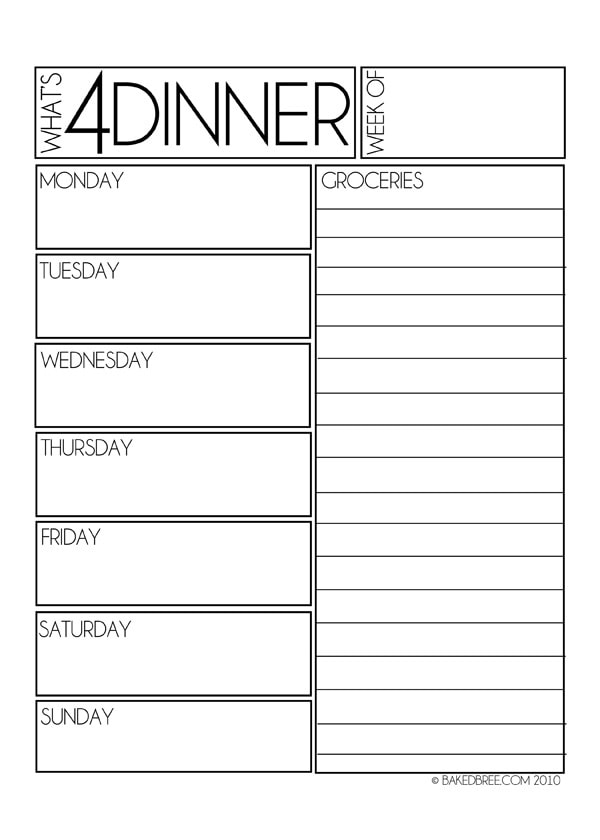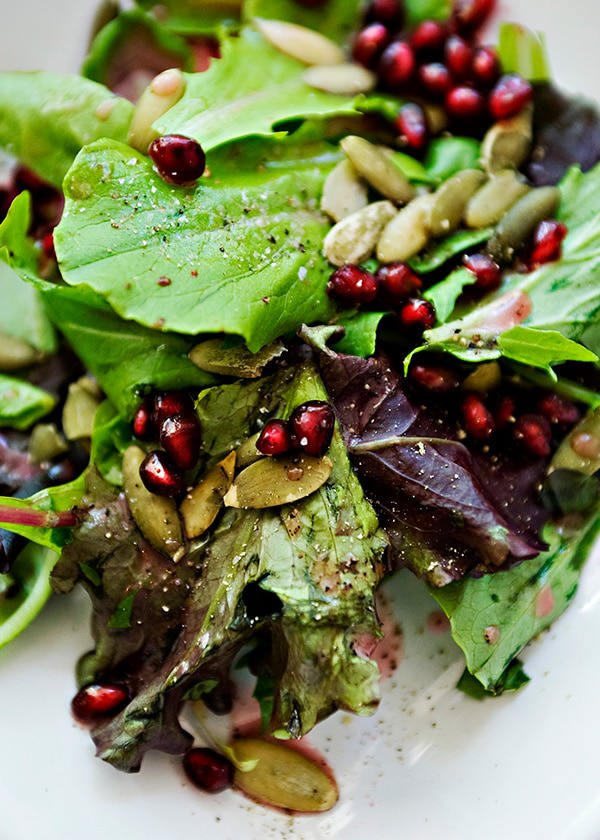Louisiana cuisine comes to your kitchen with this Duck and Shrimp Gumbo—a more exotic take on the Cajun staple with meats and veggies galore.

When I make a gumbo, it is an event.
I start days in advance with the roux. I spend hours stirring it, ensuring it reaches that perfect color and consistency. Then I put it in the fridge for a day to let it rest. The next day, I take the roux and make the gumbo. Do I eat it once I’m done? Nope, even though the smell has this hypnotic effect on me and almost impels me to grab a spoon and start slurping. Instead, I put the entire pot in the fridge (after some expert Tetris-like maneuvering with the jars already occupying space on the shelf) and let the flavors coalesce (which is a fancy word for “thicken and get yummy”). Then, ONLY then, do I pour myself a bowl.
I’ve shared a number of gumbo recipes with you on the site, but this is the first that includes duck. I don’t think to search for duck when I’m at the grocery store and it’s to my own detriment that I don’t. It’s a lovely meat, dark and packed with flavor. If ever I was going to use duck, it’s appropriate I do so for a recipe for gumbo. Duck is a regular feature on French menus and, as gumbo has French roots, it makes sense I put them together.
If you’ve never made gumbo, then welcome to a cuisine you’ll surely go back to on the regular. If you’ve made gumbos before but never with duck, then you are in for a treat. You may never go back to duck-less gumbo again!
What’s the Difference Between Gumbo and Jambalaya?
Planning a trip to Louisiana? If so, you need to know how gumbo and jambalaya differ (and how they resemble each other). First, their origins: Gumbo is more of a French/African influenced import to Louisiana, whereas Jambalaya’s influence hails more from Spain. This informs some of their ingredients. Jambalaya is kind of like a paella (there are those Spanish roots showing). It’s a solid-food feast with long-grained rice included (the short-grained variety will just turn to mush). Gumbo, on the other hand, is more like a stew. It’s still loaded with ingredients, sure, but there’s a bit of broth that keeps it all together. It also features a roux—a mix of fat and flour—which is a nod to its French roots. Last, though this may not be a strict rule, Jambalayas feature a wider variety of meats: ham, shrimp, sausage, chicken. Gumbo can have meat but it’s usually limited to shrimp and sausage.
Ingredients
- ¼ cup butter
- ¼ cup flour
- 1 onion, diced
- 2 sticks celery, chopped
- 1 red pepper deseeded and chopped
- 1 green pepper, deseeded and chopped
- 2 cloves garlic, crushed
- 1 lb. duck breast, cut into chunks, fats removed
- 1 (14 oz.) can crushed tomato
- 2 cups chicken stock
- 2 bay leaves
- 1 tbsp Creole seasoning
- 1 lb. shrimp
- salt and pepper
- 2 green onions, finely sliced

How to Make Duck & Shrimp Gumbo
Step 1: Add the butter to a large, heavy-based pot over MEDIUM heat. Once the butter has melted, sprinkle in the flour. Stir slowly until it forms a smooth, caramel-colored roux.
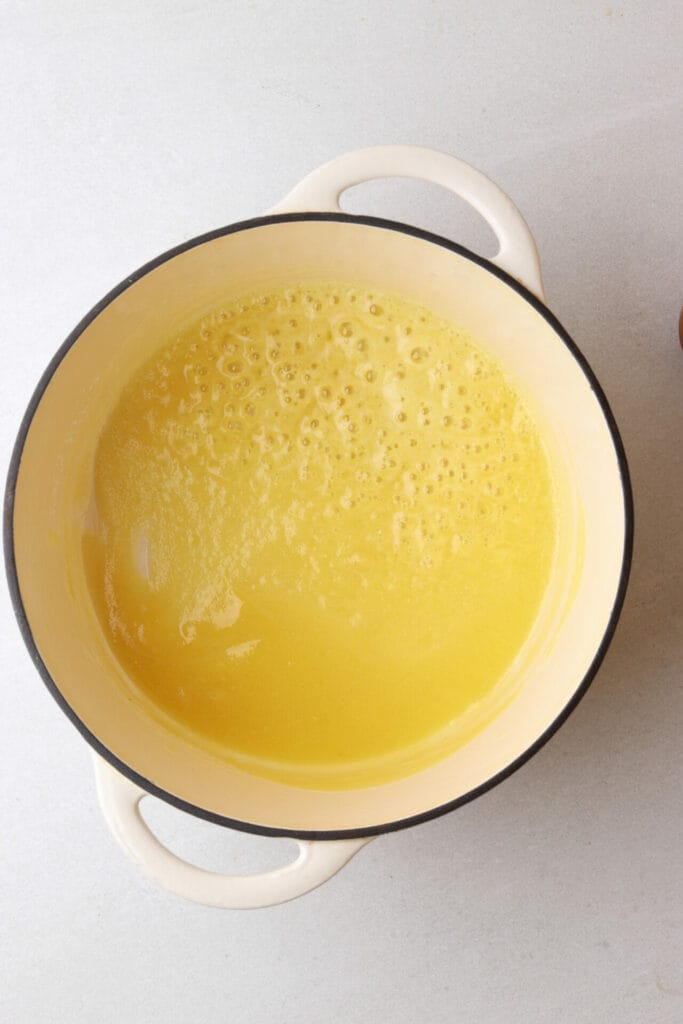
Step 2: Add the diced onion, celery, peppers and garlic. Sauté for 5 minutes.

Step 3: Add the duck, crushed tomato, chicken stock, bay leaves, Creole seasoning, and salt and pepper to the pot. Stir. Cover the pot and bring the mix to a boil. Turn down the heat and let simmer for 45 minutes, stirring occasionally.
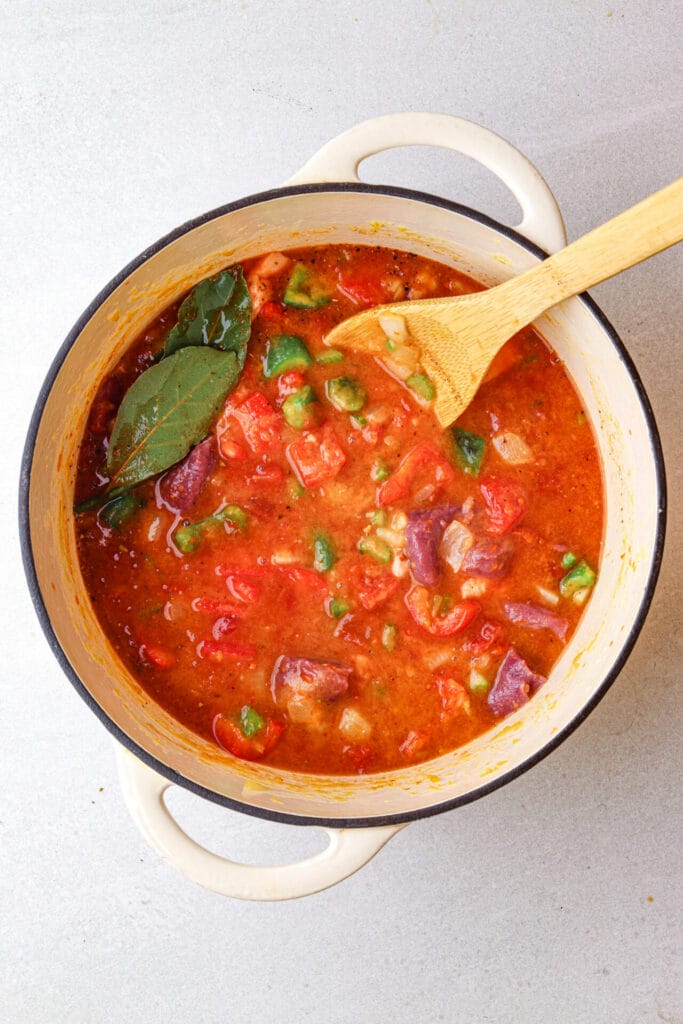
Step 4: If the gumbo hasn’t thickened, remove the lid and continue to let simmer. Add the shrimp and cook for 5 minutes, until the shrimp has turned an opaque white.
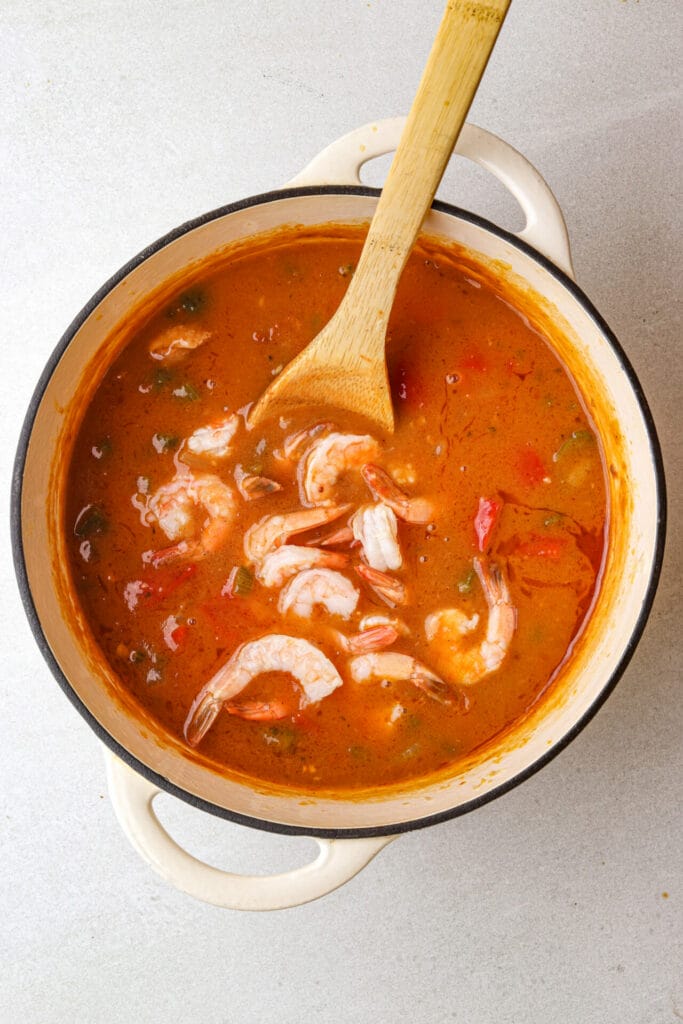
Step 5: Remove the bay leaves. Sprinkle the green onions over and serve. Enjoy!
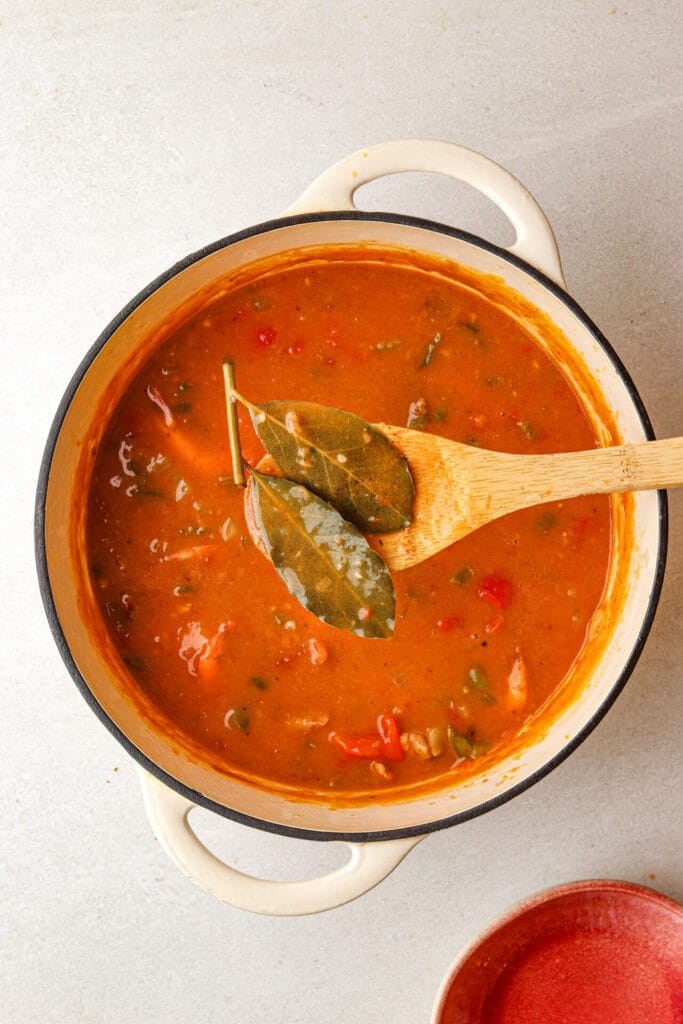
FAQs & Tips
Once you’ve cooked the gumbo, let it cool. I usually just put the entire pot (covered) in the fridge and leave it there for up to 3 days, knowing I will go back to it in no time. You, however, can always transplant the gumbo to an airtight container. If you made a lot and want to store it for longer, you can freeze it. For this, I would use an airtight container. It should keep in the freezer for up to 3 months. Before reheating, let it thaw in the fridge overnight, then warm it back up in the microwave or on the stove.
Bay leaves don’t soften during the cooking process so the texture is less than preferable. What’s more, it may lead to upset tummies. If you do decide to leave them in your gumbo, advise your guests of their presence so they can decide for themselves and fish out the leaves if they so desire.
A good roux takes time; it should not be rushed (roux-shed?). That’s the secret right there. You have some leniency with regards to the fat you use, with oil and butter being the prime candidates, but the one thing you must abide by is the length of time it takes to attain the right color and consistency. Don’t be tempted to turn up the temperature. Keep it low and stir consistently; it makes all the difference.
One thing Cajun and Creole cuisines can agree on is the importance of onion, bell peppers, and celery in their respective dishes. That’s why the three veggies are shown some respect and called the “holy trinity”. You’ll notice the list of ingredients for this recipe first lists the flour and oil (i.e. the roux) and then onion, peppers, and celery. Yep, that’s in order of importance.
Yes. In fact, letting the gumbo chill (literally, in the fridge) for a few days will let the flavors meld and make for a tastier gumbo. If you don’t have the time to make it days in advance, you can at least make the roux before attending to the other ingredients. Show it the high level of attention it deserves when cooking it, then store it in the fridge until you’re ready to cook the gumbo.
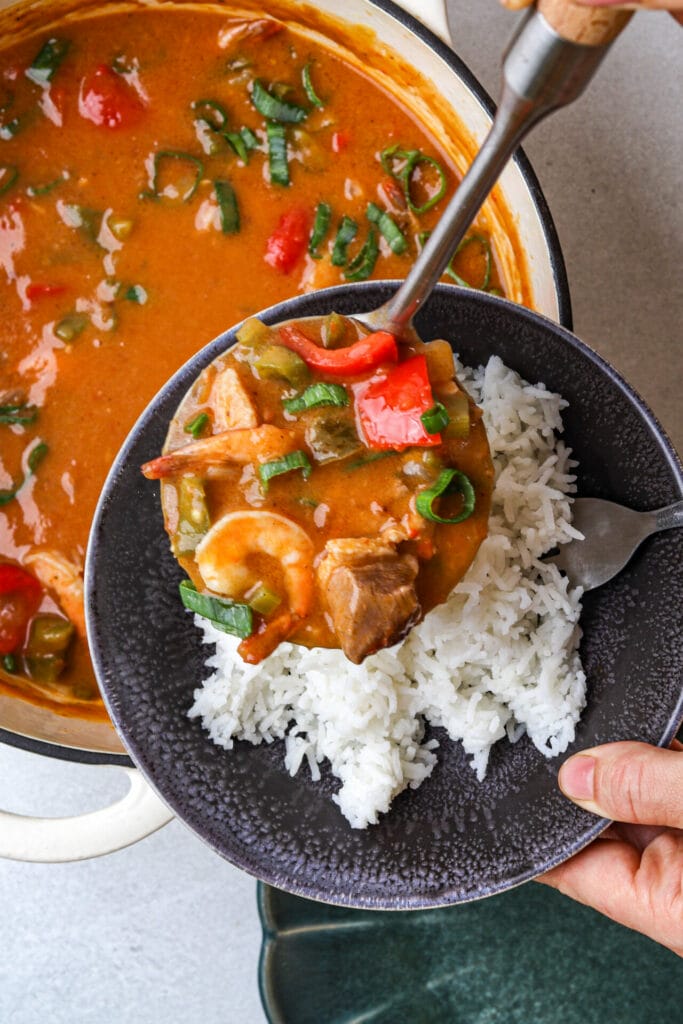
Serving Suggestions
Baked Rice: I’m not even sure you can call this a side dish, considering how regularly rice gets served with gumbo. In any case, here’s a simple recipe you can follow for a traditional gumbo dish.
Easy Baked Sweet Potato: Another simple side that goes well with gumbo. Do I sometimes chop it up and add it to my gumbo? Yes, I do.
Roasted Brussels Sprouts Recipe: Unlike the sweet potato, I am not tempted to add brussels sprouts to my gumbo. I prefer to eat my sprouts separately because they are just that good.
Vegan Chocolate Pudding with Coconut Whipped Cream: Chocolate and coconut have a hold on me. I submit to them gladly. Yum!
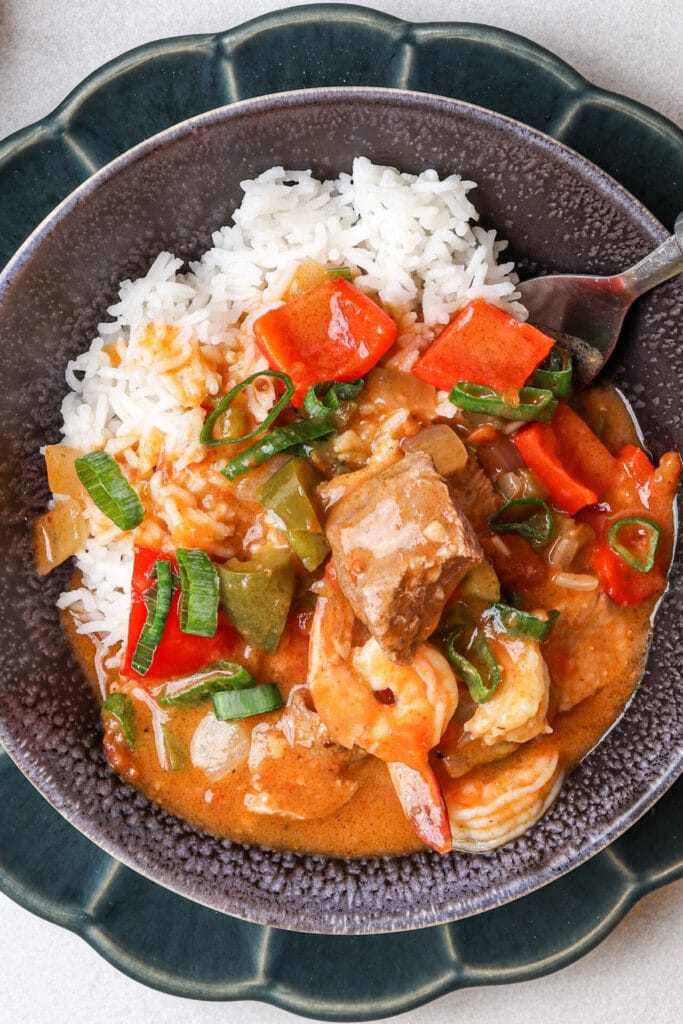
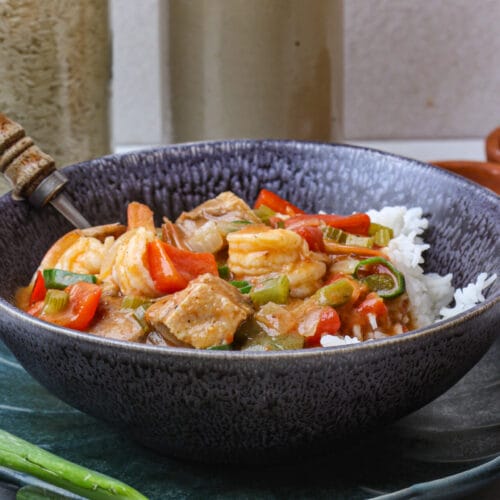
Duck and Shrimp Gumbo
Ingredients
- ¼ cup butter
- ¼ cup flour
- 1 onion diced
- 2 sticks celery chopped
- 1 red pepper deseeded and chopped
- 1 green pepper deseeded and chopped
- 2 cloves garlic crushed
- 1 lb. duck breast cut into chunks, fat removed
- 1 (14 oz.) can crushed tomatoes
- 2 cups chicken stock
- 2 bay leaves
- 1 tbsp Creole seasoning
- 1 lb. shrimp
- salt and pepper
- 2 green onions finely sliced
Instructions
- Add the butter to a large, heavy-based pot over MEDIUM heat. Once the butter has melted, sprinkle in the flour. Stir slowly until it forms a smooth, caramel-colored roux.
- Add the diced onion, celery, peppers, and garlic. Saute for 5 minutes.
- Add the duck, crushed tomato, chicken stock, bay leaves, Creole seasoning, and salt and pepper to the pot. Stir. Cover the pot and bring the mix to a boil. Turn down the heat and let simmer for 45 minutes, stirring occasionally.
- If the gumbo hasn’t thickened, remove the lid and continue to let simmer. Add the shrimp and cook for 5 minutes, until the shrimp has turned an opaque white.
- Remove the bay leaves. Sprinkle the green onions over and serve. Enjoy!
Nutrition

